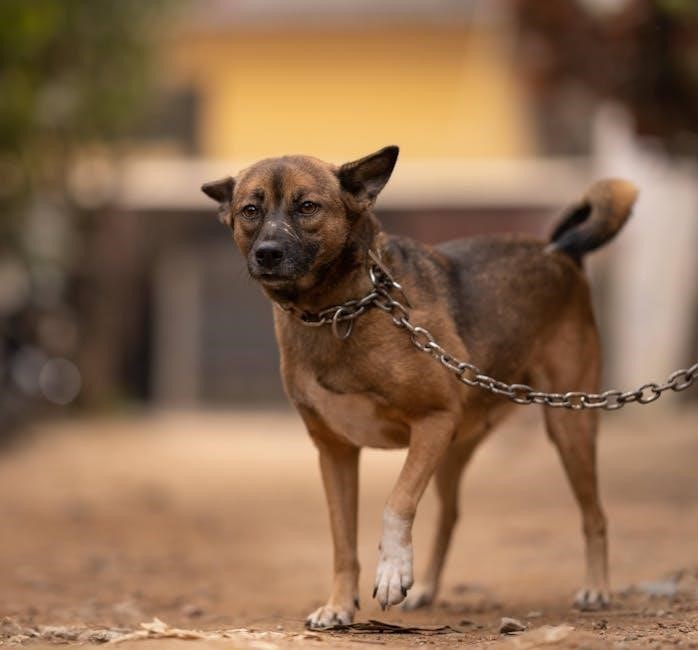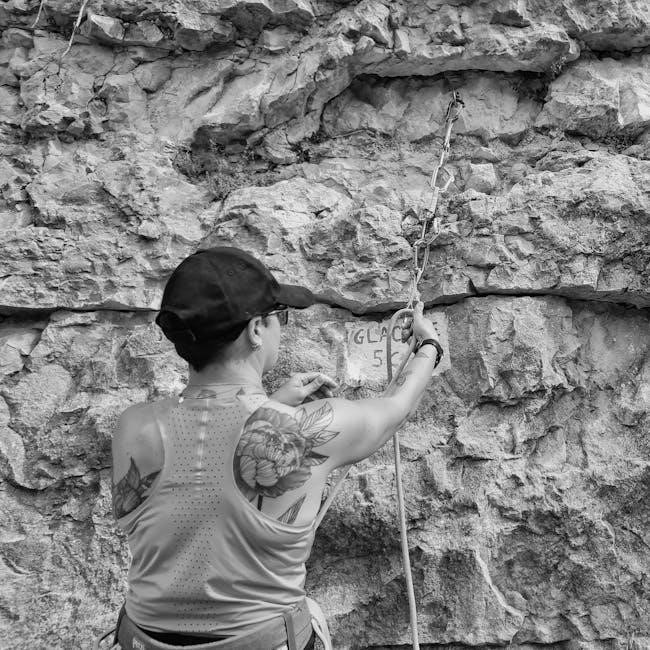Selecting the right roller chain size is crucial for optimal performance and durability. This guide helps you understand chain dimensions, types, and applications to ensure accurate sizing and reliability.
1.1 What is a Roller Chain?
A roller chain is a type of power transmission chain consisting of interconnected links with rollers. It is designed to transmit mechanical power between gears or sprockets. The chain comprises rollers, pins, plates, and bushings, working together to facilitate smooth motion. Roller chains are commonly used in bicycles, motorcycles, and industrial machinery. Their durability and efficiency make them a crucial component in various applications, ensuring reliable performance under different loads and speeds.
1.2 Importance of Choosing the Right Chain Size
Choosing the correct roller chain size is essential for ensuring optimal performance, efficiency, and longevity of machinery. A properly sized chain minimizes wear on components, reduces energy consumption, and prevents premature failure. Incorrect sizing can lead to chain slippage, excessive noise, and increased maintenance costs. It also compromises safety, especially in industrial or high-load applications. Selecting the right chain size ensures smooth operation, reduces downtime, and enhances overall system reliability, making it a critical step in equipment setup and maintenance.

Understanding Roller Chain Sizes
Roller chain sizes are defined by pitch, inner width, and roller diameter. These dimensions ensure compatibility with sprockets and applications, optimizing performance and reliability in various machinery.
2.1 Pitch and Its Significance
The pitch is the distance between the centers of two adjacent rollers in a roller chain. It is a critical measurement as it determines the chain’s compatibility with sprockets. A standard pitch ensures smooth engagement with the teeth of the sprockets, preventing slippage and wear. Common pitches include 0.5″, 0.75″, and 1″. Choosing the correct pitch is essential for maintaining the chain’s performance and longevity in various applications. Proper alignment and fit are achieved when the pitch matches the sprocket teeth.
2.2 Inner Width and Roller Diameter
Inner width refers to the distance between the inner plates of a roller chain, while roller diameter measures the size of the rollers. Both dimensions are critical for ensuring compatibility with sprockets and optimal performance. A larger inner width allows for heavier loads but may not fit smaller sprockets. The roller diameter affects the chain’s durability and efficiency, with larger diameters offering greater strength. Proper alignment of these dimensions ensures smooth operation and prevents premature wear. Accurate measurements are essential for selecting the right chain for your specific application.
2.3 Common Size Designations
Roller chains are often designated by standard size codes, such as 40, 50, or 60. These numbers represent the chain’s pitch in eighths of an inch, with 40 indicating a 0.5-inch pitch and 60 a 0.75-inch pitch. Common designations also include specifications for inner width and roller diameter, ensuring compatibility with sprockets. These standardized sizes simplify selection, installation, and maintenance, making it easier to match chains to specific applications and equipment. Always refer to manufacturer guidelines for precise sizing and compatibility.

How to Measure a Roller Chain
Measuring a roller chain involves determining its pitch, inner width, and counting the number of links. Accurate measurements ensure proper fit and functionality.
3.1 Measuring Pitch
Measuring the pitch of a roller chain is essential for determining its size. The pitch is the distance between the centers of two adjacent rollers. To measure it accurately, place the chain on a flat surface and use a caliper or ruler to gauge the distance between two pins or bushings. Ensure the chain is straight and not stretched for an accurate reading. Proper measurement helps in selecting the correct chain size for your application, ensuring smooth operation and preventing premature wear.
3.2 Measuring Inner Width
The inner width of a roller chain refers to the distance between the inner plates. To measure it accurately, place the chain on a flat surface and use a caliper or ruler. Position the tool across the inner edges of two adjacent plates and record the measurement. This dimension is critical for ensuring compatibility with sprockets and proper fitment. Accurate measurement prevents issues like misalignment or excessive wear, ensuring smooth operation and longevity of the chain in its intended application.
3.3 Counting Chain Links
Counting chain links is essential for determining the correct length of a roller chain. Start by identifying the number of pitch lengths between the links. For an open chain, simply count each link individually. If the chain is looped, divide the total length by the pitch to find the number of links. Ensure accuracy by counting both inner and outer links. This step is vital for maintaining proper tension and preventing slippage or premature wear on the chain and sprockets, ensuring optimal performance in any mechanical system.

Selecting the Right Chain for Your Application
Selecting the right chain involves assessing load requirements, operational speeds, and environmental factors. Proper chain selection ensures efficiency, durability, and optimal performance in various mechanical systems.
4.1 Determining the Number of Teeth on Sprockets
Determining the number of teeth on sprockets is essential for proper chain alignment and performance. The number of teeth affects the pitch diameter and chain wrap angle. For smaller sprockets, fewer teeth can lead to increased wear and potential chain slippage. Larger sprockets with more teeth provide a smoother operation and better load distribution. It is crucial to ensure compatibility between the sprocket and chain sizes to maintain optimal gear engagement and minimize the risk of mechanical failure. Proper calculation ensures efficient power transmission and system longevity.
4.2 Calculating Chain Length
Calculating chain length ensures proper fitment and performance. Measure the center distance between sprockets and use the formula: Chain Length = (Number of Teeth on Large Sprocket + Number of Teeth on Small Sprocket) × Pitch ÷ 2 + 2 × Offset. For open-loop systems, add 12 inches for every additional foot of center distance. Always consider chain stretch and wear when determining the final length. Using online calculators or manufacturer guidelines can simplify the process and ensure accuracy. Proper chain length prevents slippage and extends system lifespan.
4.3 Considering Load and Speed Requirements
Assessing load and speed is critical for choosing the right chain. Higher loads and speeds require stronger chains, often heavy-duty or specialty types. Consider the weight, torque, and RPM of your application. Chains with thicker plates or reinforced designs handle heavy loads better, while high-speed chains may need lubrication or specialized coatings. Always refer to manufacturer charts or consult experts for precise recommendations. Balancing load and speed ensures efficient operation, prevents premature wear, and maximizes system reliability. Proper selection enhances performance and extends equipment lifespan.

Types of Roller Chains
Roller chains come in various types, each designed for specific applications. Standard chains are versatile, while heavy-duty chains offer enhanced strength for demanding environments. Specialty chains, like O-ring or zinc-coated, provide additional durability and resistance for unique conditions.
5.1 Standard Roller Chains
Standard roller chains are the most commonly used type, offering a balance of strength and versatility. They are suitable for a wide range of applications, from light-duty machinery to industrial equipment. These chains typically feature a simple design with uniform pitch and roller diameters, making them easy to install and maintain. Their durability and cost-effectiveness make them a preferred choice for many industries. Proper sizing and maintenance ensure optimal performance and longevity in various operational settings.
5.2 Heavy-Duty Roller Chains
Heavy-duty roller chains are designed for high-stress environments and demanding applications. They feature thicker side plates and larger rollers for increased strength and load capacity. These chains are ideal for heavy machinery, construction equipment, and industrial settings where durability is critical. Their robust construction minimizes wear and tear, ensuring longer service life compared to standard chains. Proper installation and regular maintenance are essential to maximize their performance and handle heavy loads effectively.
5.3 Specialty Chains (e.g., O-Ring, Zinc-Coated)
Specialty roller chains offer unique features for specific applications. O-ring chains are designed with sealed joints to retain lubrication, reducing wear and extending life. Zinc-coated chains provide corrosion resistance, ideal for harsh environments. These chains cater to particular needs, such as high lubrication retention or rust resistance, ensuring optimal performance in diverse settings. Proper selection based on application requirements is essential to leverage their specialized benefits effectively.

Materials and Finishes
Roller chains are made from durable materials like carbon steel for strength and stainless steel for corrosion resistance. Plated and coated options enhance longevity and performance.
6.1 Carbon Steel Chains
Carbon steel chains are the most common choice, offering exceptional strength and durability. They are heat-treated for optimal hardness, making them ideal for heavy-duty applications. With proper maintenance, they resist wear and corrosion effectively, ensuring long service life across various industries. Their versatility and cost-effectiveness make them a preferred option for both industrial and everyday use, providing reliable performance under diverse conditions.
6.2 Stainless Steel Chains
Stainless steel chains are highly corrosion-resistant, making them ideal for harsh environments. They are durable, heat-resistant, and suitable for applications requiring clean conditions. Often used in food processing and marine industries, these chains offer excellent strength and longevity. Their smooth operation and minimal maintenance needs make them a popular choice for demanding scenarios. While more expensive than carbon steel, their ability to withstand corrosive conditions justifies the investment in industries prioritizing durability and hygiene.
6.4 Plated and Coated Chains
Plated and coated chains offer enhanced corrosion resistance and durability. Zinc-plated chains are common for outdoor use, while nickel-plated chains provide added protection in harsh environments. Coatings like nylon or Teflon reduce friction and wear, extending chain life. These chains are ideal for applications requiring minimal maintenance and resistance to rust. They are widely used in food processing, marine, and automotive industries. The protective layers ensure longevity and performance in demanding conditions, making them a cost-effective solution for specific industrial needs.
Installation and Maintenance Tips
Proper chain installation and regular maintenance ensure optimal performance. Tighten chains correctly to avoid slippage, lubricate links, and inspect for wear. Regular upkeep extends chain life significantly.
7.1 Proper Chain Tensioning
Proper chain tensioning is essential for smooth operation. Over-tightening can cause bearing wear, while under-tightening leads to slippage. Use a tensioner or adjust sprockets to maintain optimal slack. Check tension regularly, especially after installation, and ensure even pressure across all links. Proper tensioning extends chain life and prevents premature wear. Always refer to manufacturer guidelines for specific tensioning requirements and techniques tailored to your application. Regular inspections and adjustments are key to maintaining peak performance and minimizing downtime.
7.2 Lubrication Practices
Proper lubrication is essential for reducing wear and preventing corrosion. Use high-quality, lithium-based or synthetic greases suitable for your chain type. Apply lubricant during installation and re-lubricate regularly, especially in dusty or high-temperature environments. Avoid using substances like WD-40, as they attract dirt. Lubricate the inner links and rollers, ensuring even coverage. Clean the chain before applying lubricant to remove dirt and debris. Regular lubrication extends chain life, reduces noise, and maintains smooth operation. Always follow manufacturer recommendations for lubricant type and application frequency.
7.3 Inspection for Wear and Damage
Regularly inspect your roller chain for signs of wear and damage. Look for rust, stretched links, or binding joints. Check pins, rollers, and plates for excessive wear or bending. Inspect for loose or damaged pins, as these can lead to chain failure. Replace the chain if links are elongated or if rust is present. Clean the chain before inspection to ensure accurate assessment. Addressing wear early prevents costly repairs and ensures smooth operation. Replace chains showing significant wear to maintain efficiency and safety.

Common Mistakes to Avoid
Avoid incorrect chain sizing, improper installation, and neglecting maintenance. These errors lead to premature wear, reduced efficiency, and potential system failure, ensuring optimal performance is crucial.
8.1 Incorrect Chain Size Selection
Incorrect chain size selection is a common mistake that can lead to poor performance, increased wear, and premature failure. Choosing a chain with the wrong pitch or inner width can cause misalignment, excessive stress, and inefficient power transmission. A chain that is too tight or too loose may also lead to accelerated wear on sprockets and other components. For instance, a bike chain with a stretched pitch beyond 0.5 inches can cause poor shifting and reduced efficiency. Always ensure precise measurements and consult manufacturer specifications to avoid such errors.
8.2 Improper Installation
Improper installation of a roller chain can significantly reduce its performance and lifespan. Common mistakes include incorrect alignment with sprockets, failure to properly connect links, and not following manufacturer-specific instructions. For example, using the wrong tool to press pins or rivets can lead to uneven connections, causing chain stretch or wear. Additionally, neglecting to tighten or lubricate the chain during installation can result in premature wear and noise. Always ensure the chain is correctly seated on the sprockets and that all links are securely fastened to prevent operational issues.
8.3 Neglecting Maintenance
Neglecting regular maintenance can lead to premature wear, corrosion, and reduced chain performance. Failing to lubricate the chain can cause metal-to-metal friction, leading to excessive heat and wear. Additionally, ignoring inspections for worn or damaged links can result in chain failure. Cleanliness is also crucial; dirt and debris can accelerate wear and degrade chain components. Regular lubrication, cleaning, and inspections are essential to ensure optimal chain longevity and performance. Neglecting these steps can lead to costly repairs and downtime, emphasizing the importance of a consistent maintenance routine.

Industry-Specific Chain Requirements
Different industries require specialized chains to meet unique demands. Industrial machinery needs heavy-duty chains, agriculture demands corrosion-resistant options, and automotive applications require precise, high-performance chains for reliability and efficiency.
9.1 Chains for Industrial Machinery
Industrial machinery often requires heavy-duty roller chains designed for high load capacities and durability. These chains typically feature robust materials and heat-treated components to withstand harsh environments. Common industrial chains include double-pitch and extended-life options, which minimize wear and maximize service life. Proper sizing and compatibility with sprockets are critical to ensure smooth operation and prevent premature failure. Additionally, specialized coatings or treatments may be applied to enhance resistance to corrosion or extreme temperatures, making them suitable for demanding industrial applications and ensuring reliable performance over time.
9.2 Chains for Agricultural Equipment
Roller chains for agricultural equipment must endure harsh conditions, including exposure to moisture, dirt, and heavy loads. Chains used in tractors, harvesters, and other farm machinery are typically designed with high-strength materials and rust-resistant coatings to combat corrosion. Lubrication is essential to maintain chain performance and extend service life. Agricultural chains often require specific pitch and width dimensions to fit legacy equipment, emphasizing the importance of proper sizing and compatibility. Regular maintenance, such as cleaning and lubrication, ensures reliable operation and minimizes downtime during critical farming seasons.
9.3 Chains for Automotive Applications
Roller chains in automotive applications, such as motorcycles and bicycles, require durability and resistance to wear. These chains often feature nickel-plated or zinc-coated finishes for corrosion resistance. Lubrication practices are critical to maintain chain performance and extend lifespan. Automotive chains are designed to handle high torque and varying speeds, making proper sizing and material selection essential. Regular inspection for stretch or damage ensures safety and efficiency, while replacement is necessary when wear exceeds recommended limits to prevent system failure.

Troubleshooting Common Issues
Identify and resolve issues like chain slippage, excessive noise, or premature wear by inspecting for misalignment, improper tension, or lubrication deficiencies. Regular maintenance ensures optimal performance.
10.1 Chain Slippage
Chain slippage occurs when the chain skips teeth on the sprocket, often due to improper tension, worn components, or misalignment. This can lead to reduced efficiency and potential damage. Regularly inspect sprockets for wear and ensure the chain is properly tensioned. Lubrication also plays a key role in preventing slippage by reducing friction. If slippage persists, consider replacing worn parts or adjusting the system’s alignment to restore proper functionality and prevent further issues.
10.2 Excessive Noise
Excessive noise from a roller chain often indicates wear, misalignment, or lack of lubrication. Worn or damaged components can cause rattling or clattering sounds. Regular lubrication with appropriate grease helps reduce friction and noise. Inspect the chain and sprockets for wear and replace parts as needed. Proper alignment of the chain and sprockets is essential to minimize noise. Addressing these issues promptly can extend the chain’s lifespan and ensure smoother operation. If noise persists, consider consulting a professional for further inspection and maintenance.
10.3 Premature Wear
Premature wear on a roller chain can result from improper sizing, insufficient lubrication, or excessive loads. Misaligned sprockets and chain stretch also accelerate wear. Regular inspections help identify worn components early. Replacing stretched or damaged links and ensuring proper chain tension can prevent further degradation. Using high-quality materials and maintaining optimal operating conditions are key to extending chain life. Addressing wear promptly avoids costly replacements and downtime, ensuring efficient and reliable system performance over time. Proper maintenance practices are essential for minimizing premature wear and maximizing chain longevity.
Proper roller chain sizing and maintenance are critical for optimal performance and longevity. By following this guide, you can ensure reliable operation, reduce wear, and enhance efficiency in your applications.
11.1 Summary of Key Points
11.2 Final Tips for Optimal Chain Performance
For optimal chain performance, ensure proper installation by following manufacturer guidelines; Regularly inspect chains for wear and damage, replacing components as needed; Maintain correct tension to prevent slippage and reduce stress on sprockets. Lubricate chains consistently to minimize friction and extend lifespan. Store chains in clean, dry environments when not in use. Always refer to industry standards and manufacturer recommendations for specific applications. By following these practices, you can achieve reliable operation, reduce maintenance costs, and maximize the service life of your roller chains.

Additional Resources
Explore manufacturer guides, online calculators, and technical standards for detailed roller chain specifications and applications, ensuring comprehensive understanding and informed decision-making.
12.1 Manufacturer Guides and Catalogs
Manufacturer guides and catalogs are essential resources for selecting the right roller chain. They provide detailed specifications, sizing charts, and application recommendations. These documents often include technical drawings, material options, and performance ratings. By referencing these guides, users can ensure compatibility with their machinery and operational requirements. Many manufacturers also offer troubleshooting tips and maintenance advice. Catalogs typically cover standard and specialty chains, making them invaluable for both novice and experienced professionals. Always consult the manufacturer’s documentation for accurate and reliable information.
12.2 Online Calculators and Tools
Online calculators and tools simplify roller chain sizing and selection. They allow users to input specific parameters such as pitch, sprocket teeth, and application requirements to determine the ideal chain length and type. Many tools also provide tutorials or guides to help users understand complex calculations. These resources are invaluable for professionals and DIYers alike, ensuring accurate measurements and optimal chain performance. By leveraging these tools, users can save time and avoid errors in their chain sizing process.
12.3 Technical Specifications and Standards
Technical specifications and standards provide detailed guidelines for roller chain design, materials, and performance. These documents ensure compliance with industry norms, such as ISO or DIN standards, guaranteeing safety and interoperability. They cover aspects like chain pitch, tensile strength, and material quality, helping manufacturers and users maintain consistency. Adhering to these standards minimizes risks and enhances the reliability of roller chains in various applications. Always refer to the latest technical specifications for accurate and reliable chain selection.

